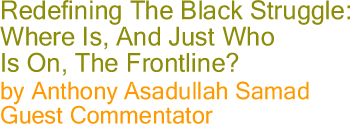
Issue 131 - March 24 2005
Printer Friendly Version
|
For those of us who maintain some constant involvement in the many, many conflicts that face Blacks in the 21st Century, individually and in the collective, what one fights for and who one is fighting for, seems to always be a point of contention for some people. While some understand the complexities of black struggle – that racism manifests itself on many levels and thus has to be fought on many levels – others see the “struggle” on the one level that they deal with, and think that fight is the only battle black people are facing. Thus, if you’re not in that particular fight, you’re not fighting at all. This unsophisticated approach to black advocacy has added another layer of conflict to the already contentious inter-generational conflicts that sometimes consume black struggle. Trying to address “black struggle” these days is more the myopic focus of the civil rights or the pro-black radical movements of four generations ago. “Black struggle” in the post-Civil Rights Era has been as hard to fight as it has been to find, given the shift in overt to covert racism and the politics of race-neutrality that allow passive-aggressive attitudes to find cover in this new social construct. Black people know that things are happening to them that they can’t explain, and systems are compromising them in ways that they never imagined (until they get caught up in the system). Just like during “separate but equal,” Blacks always knew that equal was never equal, but separate was definitely separate. Today, there is no legal “separate” (but there is a separate), and equal is still not equal, but the real problem is that the black community, in the collective, haven’t figured out how to fight “colorblindness,” which is the new Jim Crow. Blacks are conflicted as to where the struggle is, and who is on the frontline, and they constantly ask each other, “What are you doing to help the struggle?” It’s hard to fight when most don’t know where the fights are, and which fronts to fight on. And those who are fighting, see “the frontline” based on where they are. The redefinition of “black struggle,” and the stratification of “frontlines” that require Blacks to battle on many fronts, has come about as there has been a redefinition of the “black community’s” collective interests that has come with the stratification of black income and wealth. Class and wage separation within the race is something that Blacks don’t talk about as much as they should, but there is much evidence to conclude that the burgeoning black “underclass” has issues that are separate and distinct from the shrinking black middle class, and the thinning black middle-upper class. While each share some common issues on the racial front like racial profiling, the issues of the poor are not the issues of the middle class. For instance, the employment issues facing poor Blacks are different from the promotion issues facing Blacks with jobs. Police and fire academies are graduating fewer and fewer black cadets. Both groups are facing massive discrimination, but not on the same front. The crime issues that both the poor and middle class face from shared geography impact each differently – the poor, out of desperation, the middle class, out of victimization. Then when they leave the community, they’re accused of giving up on the community. The remediation issues facing poor Blacks make it impossible to let go of the public school system, while the black middle class is having problems finding quality schools that would allow their children to be able to compete for college admission, which has become highly discriminatory on another front. The access to capital issues facing both poor and middle class Blacks, discriminate differently – one on housing, the other on business loans. We can go on and on, but the point is that the struggle is on many fronts, the battle on many levels. The biggest problem is we expect all of us to fight on all fronts, but that is not even a feasibility, given that we all bring something different to the table: experiences, knowledge, energy and ideas. If we’re all fighting on the same front, it means only one thing is being done at one time and the other fronts are being left unaddressed. Until we acknowledge that the struggle has been redefined, respect what others bring to the table and that the fight is on many fronts, we’ll be fighting about where the frontline is and who is fighting for a particular struggle. The argument should be about, why aren’t more people fighting in the struggle, period. That’s where we are now – not enough in the struggle to cover all fronts. That’s the bigger problem, and should be the focus of our solution. Anthony Asadullah Samad is a national columnist, managing director of the Urban Issues Forum and author of 50 Years After Brown: The State of Black Equality In America (Kabili Press, 2005). He can be reached at www.AnthonySamad.com. |
Your comments are always welcome. Visit the Contact Us page to send e-Mail or Feedback or Click here to send e-Mail to [email protected] e-Mail re-print notice
If you send us an e-Mail message we may publish all or part of it, unless you tell us it is not for publication. You may also request that we withhold your name. Thank you very much for your readership.
|
